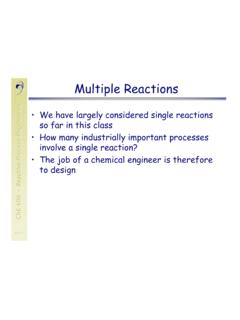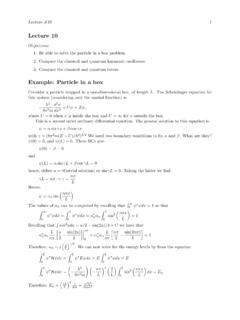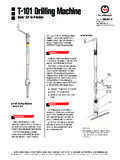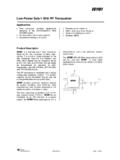Transcription of Comparing Reactors - Johnson Group
1 11 ChE 400- Reactive Process EngineeringChEChE400400--Reactive Process EngineeringReactive Process EngineeringComparing Reactors00 AXPFRAVF= 0 CSTRAVF= One of the most basic criteria of reactor selection is the reactor size necessary to achieve a desired conversion in a reaction. We saw above that these are: What would the corresponding expression be for a batch reactor?Instead of Comparing numerically the numbers for different cases, we can easily visualize the reactor volume in what is called 1/r-plots (or also Levenspiel-plots )..22 ChE 400- Reactive Process EngineeringChEChE400400--Reactive Process EngineeringReactive Process Engineering1/r-PlotsLet s look at the PFR first:00()AXAPFRAAdXVFrX = We need 1/r(X) -> let s first look at r(X)!
2 Negative 1storder: r (1-X)-11storder kinetics: r (1-X)2ndorder kinetics: r (1-X)2zero order kinetics: r f(X)rX1 or 1 or XXeqeqr-1X1 or 1 or XXeqeqinverse (1/r) plot:33 ChE 400- Reactive Process EngineeringChEChE400400--Reactive Process EngineeringReactive Process Engineering1/r - Plotsr-1 XXAX eqoperating pointpointfor CSTR operating linelinefor PFRr-1 XXAn > 0n < 0 Volume PFR ? Volume PFR ? CSTR operates at lowest PFR operates at highest Volume PFR ? Volume PFR ? Volume PFR ? Volume PFR ? CSTR operates at lowestCSTR operates at lowest PFR operates at highestPFR operates at highest44 ChE 400- Reactive Process EngineeringChEChE400400--Reactive Process EngineeringReactive Process EngineeringExampleThe following (brilliantly ) reaction is to be carried out isothermally in a continuous flow reactor: A B Compare the volumes of CSTR and PFR that are necessary to consume 90% of A.
3 The entering molar and volumetric flow rates are 5 mol/h and 10 L/h of pure A, respectively. The reaction rate coefficient is k = s-1. (What is hence the rate law?)[Assume the volumetric flow rate is constant.]55 ChE 400- Reactive Process EngineeringChEChE400400--Reactive Process EngineeringReactive Process (X)FA0/(-rA)66 ChE 400- Reactive Process EngineeringChEChE400400--Reactive Process EngineeringReactive Process EngineeringReactor CombinationsHow about combinations of PFRs and CSTRs?1/rXXtargetWhat kind of combinations ofreactors would be optimal for a (somewhat ) kinetics as shown at right?rV-1XX1 Even for ordinary kinetics, a sequenceof a CSTR and a PFR might be used(typically for cost reasons), where the CSTR is then operated at low conversion ( first), followed by thePFR to achieve the final desired 400- Reactive Process EngineeringChEChE400400--Reactive Process EngineeringReactive Process EngineeringReactors in Series: CSTR Cascader-1XX1X2X3X1X2X3 CSTR 1 CSTR 1 CSTR 2 CSTR 2 CSTR 3 CSTR 3with increasing number of CSTR s, the integral over the rV-1vsX curve will be approximated with increasing accuracyCSTR cascade approximates PFR behavior !
4 CSTR cascade approximates PFR behavior ! Optimization problemOptimization problem: for n > 1, the volume of subsequent : for n > 1, the volume of subsequent CSTRsCSTR smust decrease must decrease for minimal overall reactor (how can we see that in tfor minimal overall reactor (how can we see that in the graph above?!)he graph above?!)88 ChE 400- Reactive Process EngineeringChEChE400400--Reactive Process EngineeringReactive Process EngineeringCSTR cascade: ExampleLet s assume an irreversible 1storder reaction A -> B is conducted in a cascade of equal-volume CSTRs. If k= min-1, how long does it take to reach 90% conversion in a cascade with 1, 2, 5 and 20 CSTRs? Compare these values to a PFR!The total residence time for a cascade of n-CSTR is (read this in LDS, 109(read this in LDS, 109--111!))
5 111!):90% conversion -> CA0/CA= 10, hence:n = 1 2520 /min = PFR:PFR: PFR= - 1/r dCA= -1/k ln(CA/CA0) = --> the residence time in the CSTR cascade decreases with increas> the residence time in the CSTR cascade decreases with increasing number of ing number of Reactors towards the PFRreactors towards the PFR--limit .limit .Why would anyone nevertheless still use a CSTR over a PFR?1/01nAnACnnkC = = 99 ChE 400- Reactive Process EngineeringChEChE400400--Reactive Process EngineeringReactive Process EngineeringHow about a PFR cascade?PFR- cascades .. (However, 1010 ChE 400- Reactive Process EngineeringChEChE400400--Reactive Process EngineeringReactive Process Engineering Repairing low X: Recycle ReactorsrecycleexitFRF=recycle ratio R:FA0= R FAeFA,inFAeFA,recFA,outThe simplest way of improving a low conversion is through a recycle loop: a part of the product stream is fed back to the reactor inlet (without prior separation!)
6 This is called a recycle reactorrecycle s do the mass balance:1111 ChE 400- Reactive Process EngineeringChEChE400400--Reactive Process EngineeringReactive Process Engineering Repairing low X: Recycle ReactorsrecycleexitFRF=recycle ratio R:FA0= R FAeFA,inFAeFA,recFA,out00 1 AAAXFF == overall conversion:,00 AAinAAeAAexFFRFFRF + ===++ per-pass conversion:1?1? 1?AAXx ==++testtest: R : R 00::RR ::The simplest way of improving a low conversion is through a recycle loop: a part of the product stream is fed back to the reactor inlet (without prior separation!). This is called a recycle reactorrecycle for the result!1212 ChE 400- Reactive Process EngineeringChEChE400400--Reactive Process EngineeringReactive Process EngineeringRecycle Reactor: DesignFrom PFR design:outinFAAFdFVr= Assume 1storder rctn: rA= k cA= k FA/ VFurther assume V= const.
7 : Vin= V0(Ve= V0!)rA= k FA0(1)00000(1)(1)(1)ln(1)ln1(1)eeRFeeAAe eFRFRVV R FVFFdFVRRkFkFRFkRF++ ++ = = += ++ ++ rAin design equation :V = V = V = V = FA0FA,inFAeFA,rec= R FAeFA,outR R 00: : RR.









